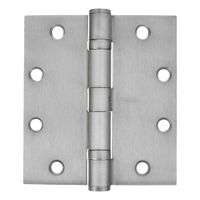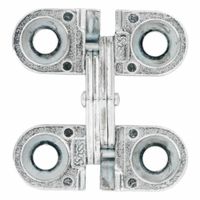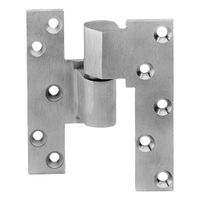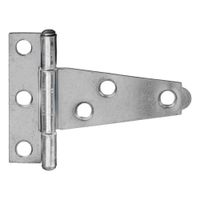Call +(254) 703 030 000 / 751 483 999 / 721 704 777
.....Read More
Frequently Asked Questions
What are the different types of hinges and their uses?
Hinges are mechanical bearings that connect two solid objects, allowing only a limited angle of rotation between them. They are essential components in various applications, from doors and cabinets to industrial machinery.
Here are some common types of hinges and their uses: * Butt Hinge: The most common type, consisting of two leaves joined by a pin. Ideal for standard doors and cabinets.
* Piano Hinge (Continuous Hinge): A long, narrow hinge that runs the entire length of the joined pieces, providing even support. Used for piano lids, folding tables, and long cabinet doors.
* Strap Hinge: Features long, visible leaves, often used for decorative purposes on gates, shed doors, and chest lids.
* T-Hinge: Combines a butt hinge leaf with a strap hinge leaf, offering strength and often a rustic aesthetic for gates and heavy doors.
* Overlay Hinge: Designed for cabinet doors that cover the cabinet opening. Common in kitchen and bathroom cabinetry.
* Inset Hinge: Used for cabinet doors that sit flush within the cabinet frame, providing a clean, built-in look.
* Concealed Hinge (Euro Hinge): Invisible when the door is closed, offering a sleek look. Widely used in modern cabinetry and furniture.
* Barrel Hinge: Small, cylindrical hinges inserted into drilled holes, often used for small boxes or crafts where a concealed look is desired.
* Spring Hinge: Contains a spring mechanism that automatically closes the door. Used for screen doors, saloon doors, and self-closing gates.
How do you install a butt hinge?
To install a butt hinge, you'll typically follow these steps:1. **Mark the hinge locations:** Decide where the hinges will be placed on both the door and the door frame. Often, hinges are placed about 7 inches from the top and 11 inches from the bottom of the door, with a third hinge in the middle for heavier doors.
2. **Score the hinge outline:** Hold the hinge in place on the door and frame and carefully trace its outline with a utility knife or pencil. This will create a guideline for mortising.
3. **Rout or chisel the mortise:** Using a router with a hinge mortising bit or a sharp chisel and mallet, carefully remove wood from within the traced outline to the depth of the hinge leaf. The goal is for the hinge leaf to sit flush with the surface of the wood.
4. **Drill pilot holes:** Once the mortise is cut, hold the hinge in place and use a drill bit smaller than the hinge screws to drill pilot holes for each screw. This prevents wood splitting.
5. **Attach the hinges:** Screw the hinge leaves securely into the mortises on both the door and the door frame using the provided screws.
6. **Hang the door:** With the hinges attached to both the door and frame, carefully lift the door and align the hinge leaves, inserting the hinge pins to connect them.Ensure the door swings freely and closes properly after installation.
What is the difference between a butt hinge and a piano hinge?
A butt hinge is a common type of hinge consisting of two plates (leaves) joined by a pin. Each leaf is typically mortised (cut into) into the door and frame, allowing them to sit flush when the door is closed. This provides a strong, low-profile connection, making them suitable for standard doors and cabinets.
A piano hinge, also known as a continuous hinge, is much longer than a butt hinge, extending along the entire length of the joined surfaces, similar to the hinge on a piano lid. It also consists of two leaves joined by a single, continuous pin. This design distributes weight and stress more evenly, providing exceptional strength and stability, especially for heavy or frequently used applications. Piano hinges are often used for folding tables, toy boxes, and, as the name suggests, piano lids, where a continuous, strong, and smooth pivot is required. The main difference lies in their length and the distribution of stress: butt hinges are short and handle concentrated stress, while piano hinges are long and distribute stress along their entire length.
How do electrified hinges work?
Electrified hinges are specialized door hinges that allow for the transfer of electrical power and/or data signals from the door frame to the door itself. This enables the operation of various electronic door hardware components, such as electric locks, access control devices, door position switches, and exit devices, without visible wires.
The core mechanism involves concealed wires or contact plates within the hinge barrel or leaves. When the door is closed, these contacts align, creating a continuous electrical pathway. Power can then be supplied from a low-voltage power supply, typically 12V or 24V DC, through the hinge to the connected hardware.
There are several types of electrified hinges, including: * **Concealed Circuit Hinges:** These have wires running through the barrel of the hinge, hidden from view.
* **Through-Wire Hinges:** These feature internal pathways for wires to pass directly through the hinge components.
* **Power Transfer Hinges (EPT):** These are specifically designed to transfer power to electric locks or other hardware on the door.The number of wires in an electrified hinge can vary depending on the complexity of the integrated electronic hardware, ranging from simple two-wire power transfer to multi-wire configurations for data and multiple functions. These hinges are crucial for integrated security systems, providing a clean and secure way to power and control electronic door hardware without compromising the aesthetics or integrity of the door assembly.
What are the benefits of using concealed hinges?
Concealed hinges offer a clean, seamless look by hiding the hinge mechanism within the cabinet door and frame. This creates a modern aesthetic, free from visible hardware that can disrupt the design. Beyond aesthetics, concealed hinges provide enhanced durability and stability due to their robust construction and the way they distribute the weight of the door. They also offer greater adjustability, allowing for precise alignment of cabinet doors in three dimensions (depth, height, and side-to-side). This makes installation and fine-tuning easier, ensuring a perfect fit. Furthermore, some concealed hinges include soft-close mechanisms, preventing doors from slamming shut and reducing wear and tear. This feature not only extends the lifespan of the cabinet but also adds a touch of luxury and quiet operation to any space.
How do you choose the right hinge for a door?
Choosing the right hinge for a door involves considering several factors to ensure proper function and longevity.
First, determine the door's weight and size. Heavier or larger doors require more robust hinges, often with more knuckles or thicker gauge metal, to support the load without sagging. Standard interior doors typically use two or three hinges, while heavier exterior or solid core doors may need four or more, or heavy-duty ball-bearing hinges for smoother operation under stress.
Next, consider the hinge material and finish. Common materials include steel, brass, and stainless steel. Steel hinges are economical and suitable for most interior applications. Brass offers a more decorative look and good corrosion resistance, while stainless steel is ideal for exterior doors or high-humidity environments due to its superior resistance to rust and corrosion. Finishes like satin nickel, oil-rubbed bronze, and polished chrome can match existing hardware and decor.
The hinge type is also crucial. Butt hinges are the most common, mortised into both the door and frame. Ball-bearing hinges are recommended for heavy or frequently used doors, providing smooth operation and durability. Spring hinges are used for self-closing doors, while pivot hinges are suitable for large, heavy doors that need to swing in both directions. Concealed hinges offer a clean, flush look as they are hidden when the door is closed.
Finally, consider the door's function and security needs. For high-traffic areas, choose durable hinges. For security, opt for hinges with non-removable pins (NRP) on outward-swinging doors to prevent hinge pin removal when the door is closed.
What are lift-off hinges used for?
Lift-off hinges are a type of hinge that allows a door or lid to be easily removed from its frame without having to unscrew the hinge leaves. This is achieved by having two separate hinge leaves: one attached to the door and the other to the frame. When the door is lifted, the pin on one leaf separates from the barrel on the other, allowing the door to be "lifted off."
These hinges are commonly used in situations where easy removal of a door or panel is beneficial. This can include: * **Cabinets and enclosures:** For easy access to the interior for maintenance or cleaning, especially for large or heavy doors.
* **Removable panels:** Such as those found on machinery or equipment, allowing for quick access to internal components.
* **Security doors:** In some cases, lift-off hinges can be designed to prevent the door from being lifted off when closed, providing security, but allowing for quick removal in an emergency.
* **Furniture:** For applications where a tabletop or lid needs to be easily removed.The design of lift-off hinges can vary, with some having a fixed pin on one leaf and a slotted barrel on the other, or vice versa. They are often made from durable materials like steel or stainless steel to withstand repeated use.
How do pivot hinges support heavy doors?
Pivot hinges support heavy doors by distributing the door's weight to the floor and the door frame, rather than relying solely on the jamb for support. Unlike traditional butt hinges that attach to the side of the door and the jamb, pivot hinges are installed at the top and bottom of the door, with a pivot point on the floor and another on the door header or frame.
This unique design allows the door's weight to be primarily borne by the floor pivot, which is typically reinforced and anchored securely. The top pivot stabilizes the door and guides its rotation. Because the weight is supported from below, there is less stress on the door frame, making pivot hinges ideal for very heavy or oversized doors that might otherwise sag or cause damage to a traditional hinge setup. The pivot mechanism also provides a smooth and stable swing, even with substantial door weight.
How do spring hinges automatically close doors?
Spring hinges are mechanical devices designed to automatically close doors after they've been opened. They achieve this through an internal spring mechanism that stores potential energy when the door is opened and then releases that energy to pull the door back to a closed position.
The core components of a spring hinge include two leaves (one attached to the door frame and one to the door itself), a knuckle that houses the pin, and the spring mechanism. The spring is typically coiled around the hinge pin and is put under tension during the manufacturing process or when the door is initially installed and adjusted.
When the door is opened, the movement of the hinge causes the spring to further compress or stretch, storing more energy. Once the opening force is removed, the stored energy in the spring is released, rotating the hinge leaves back towards their original, closed alignment, thereby pulling the door shut. Many spring hinges also have an adjustable tension mechanism, which allows the user to control the closing force and speed, making them suitable for various door weights and applications.
What are specialty hinges and where are they used?
Specialty hinges are a diverse category of hinges designed for specific applications that go beyond the capabilities of standard hinges. Unlike common butt hinges, specialty hinges offer unique functionalities, aesthetics, or installation methods to meet particular design or performance requirements.
They are used in a wide array of contexts. For instance, concealed hinges, often found in cabinetry and furniture, provide a clean, seamless look by being hidden from view when the door is closed. Piano hinges, also known as continuous hinges, run the full length of a door or panel, offering robust support and even distribution of weight, commonly seen on piano lids, long storage chests, and folding tables. Spring-loaded hinges, or self-closing hinges, are designed to automatically close a door or gate, which is useful for safety gates, screen doors, and fire-rated doors. Overlay hinges are used in frameless cabinets, allowing the door to "overlay" or cover the cabinet frame. Lift-off hinges allow a door or lid to be easily removed without unscrewing, which is beneficial for access panels or removable doors.
The choice of a specialty hinge depends on factors such as the material of the door/panel, weight, desired opening angle, aesthetic preference, and the specific function the hinge needs to perform.







